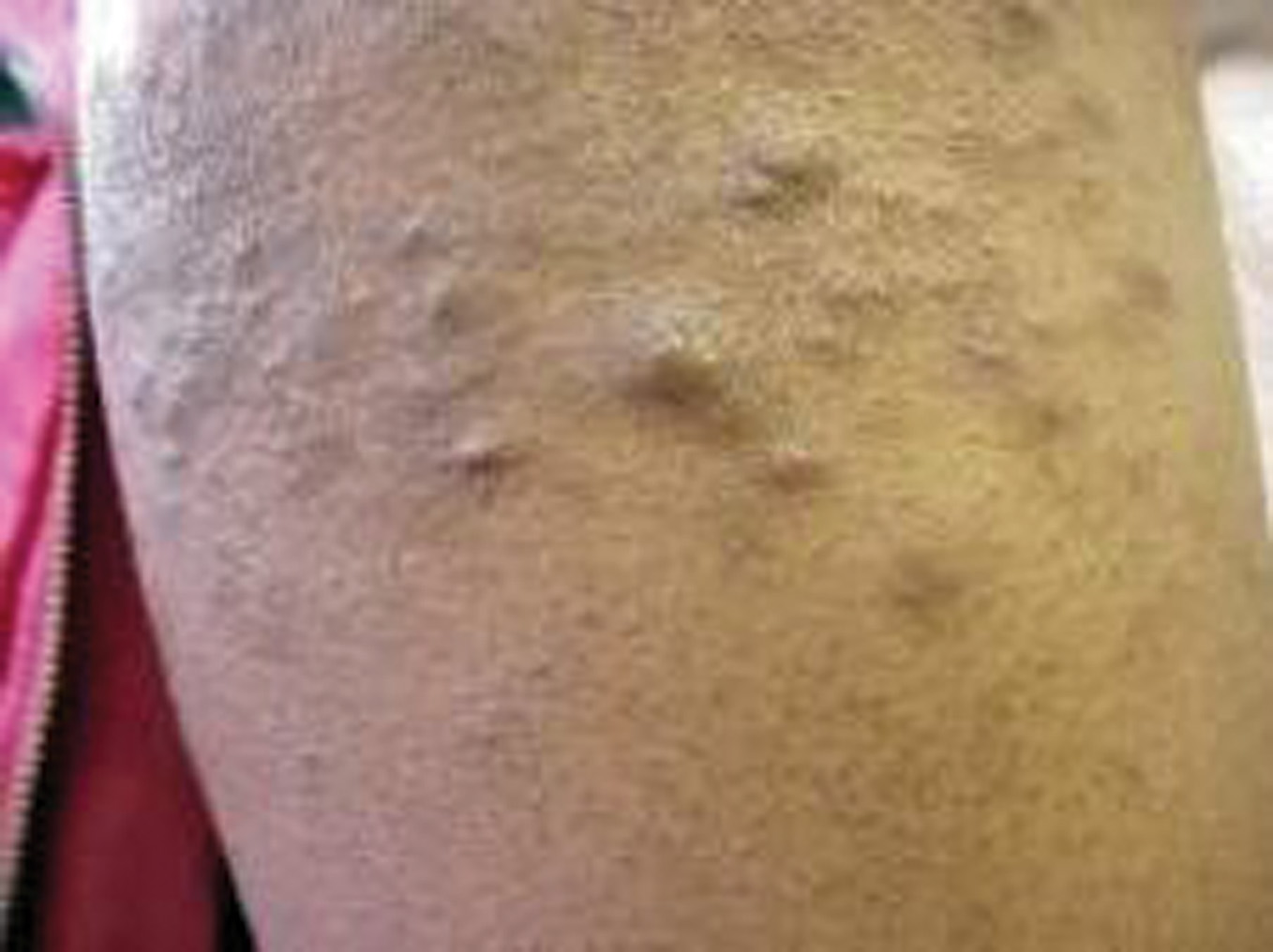Sunderamoorthy M. Srinivasan
Corresponding author: Prof. Sundaramoorthy Srinivasan e-mail:hamsrini@yahoo.co.in
How to cite an article: Srinivasan S. Enigmatic nodules on skin – a case report. Our Dermatol Online 2012; 3(3): 206-209.
 Figure 1. Nodules on right shoulder and back
|
 Figure 2. Nodules on right shoulder and back (closeup view)
|
 Figure 3. Multiple, slightly hyperpigmented nodules – Right forearm
|
|
 Figure 4. Picture of eel |
|
|
 Figure 5. Histopathology of the nodule showing bundles of smooth muscle interlacing in the dermis
|
 Figure 6. Close up view of Figure 4
|
|
Neurofibroma
|
Neurilemmoma
|
 |
 |
|
1. Characteristic round, thin-walled vessels and the mixed nature of the tumor cells.
2. There is no cytologic atypia or mitotic activity. 3. Thin spindle cells associated with thin, wavy collagen bundles.
4. Loosely spaced in clear or mucinous matrix.
|
1. Small groups of fibrils surrounded by rows of palisaded nuclei.
2. Nuclei in two parallel rows enclosing between them a space nearly homogenous anucleate material.
|
1. Holst VA, Junkins-Hopkins JM, Elenitsas R: Cutaneous smooth muscle neoplasms: clinical features, histologic findings and treatment options. J Am Acad Dermatol. 2002; 46: 491-494. 2. Garman ME, Blumberg MA, Ernst R, Raimer SS: Familial leiomyomatosis: a review and discussion of pathogenesis. Dermatology. 2003; 207: 210-213. 3. García Muret MP, Pujol RM, Alomar A, Calaf J, de Moragas JM: Familial leiomyomatosis cutis et uteri (Reed’s syndrome). Arch Dermatol Res. 1988; 280: S29-S32. 4. Sifaki MK, Krueger- Krasagakis S, Koutsopoulos A, Evangelou GI, Tosca AD: Botulinum toxin type A-treatment of a patient with multiple cutaneous piloleomyomas. Dermatology. 2009; 218: 44- 47. 5. Alam NA, Rowan AJ, Wortham NC, Pollard PJ, Mitchell M, Tyrer JP, et al: Genetic and functional analyses of FH mutations in multiple cutaneous and uterine leiomyomatosis, and renal cancer, and fumarate hydratase deficiency. Hum Mol Genet. 2003; 12: 1241-1252. 6. Reed WB, Walker R, Horowitz R: Cutaneous leiomyomata with uterine leiomyomata.- Acta Derm Venerol (Stockh). 1973; 53: 409- 416. 7. Linehan WM, Walther MM, Zbar B: The genetic basis of cancer of the kidney. J Urol. 2003; 170: 2163-2172. 8. Paul M, Attygalle D, Thambirajah M: The origins of leiomyomas. Br J Surg. 1968; 55: 9-14. 9. Virchow R: Ueber Makroglossie and pathologische Neubildung Quergestreifter Muskelfasern. Virchows Arch (Pathol anat). 1854; 7: 126-138. 10. Vellanki LS, Camisa C, Steck WD: Familial leiomyomata. Cutis. 1996; 58: 80-82. 11. Blum P, Jean L: Leiomyome eruptif de Besnier. Bull Soc F Dermatol Syph. 1954; 61: 349-350. 12. Alam M, Rabinowitz AD, Engler DE: Gabapentin treatment of multiple piloleomyoma related pain J Am Acad Dermatol. 2002; 46: S27-S29. 13. Archer CB, Greaves MW: Assessment of treatment for painful cutaneous leiomyomas[letter]. JAm Acad Dermatol. 1987; 17: 141- 142. 14. Batchelor RJ, Lyon CC, Highet AS: Successful treatment of pain in two patients with cutaneous leiomyomata with oral alpha-1 adenoreceptor antagonist, doxazosin. Br J Dermatol. 2004; 150; 775-776. 15. Alam M, Rabinowtz AD, Engler DE: Gabapentin treatment of multiple piloleiomyoma- related pain. J Am Acad Dermatol. 2002: 46(2 Suppl): S27-S29. 16. Thompson JA Jr: Theraphy for painful cutaneousleiomyomas. J Am Acad Dermatol. 1985; 13: 865-867. 17. McGinley KM, Bryant S, Kattine AA, Fitzgibbon JF, Googe PB: Cutaneous leiomyomas lack estrogen and progesterone receptor immunoreactivity. J Cutan Pathol. 1997: 24: 241-245. 18. Suárez-Peñaranda JM, Vieites B, Evgenyeva E, Vázquez-Veiga H, Forteza J: Male genital leiomyomas showing androgen receptor expression. J Cutan Pathol. 2007; 34: 946-949. 19. Archer CB, Whittaker S, Greaves MW: Pharmacological modulation of cold induced pain in cutaneous leiomyomata. Br J Dermatol. 1988; 118: 255-260. 20. Christenson LJ, Smith K, Arpey CJ: Treatment of multiple cutaneous leiomyomas with CO2 laser ablation. Dermatol Surg. 2000; 26: 319-322. 21. Gravvanis A, Kakagia D, Papadopoulos S, Tsoutsos D: Ermal skin template for the management of multiple cutaneous leiomyomas. J Cutan Med Surg. 2009; 13: 1032-1035. 23. Scheinfeld N: The role of gabapentin in treating diseases with cutaneous manifestations and pain. Int J Dermatol. 2003; 42: 491- 495. 24. Abraham Z, Cohen A, Haim S, Greaves MW: Pharmacological Modulation of cold induced pain in cutaneous leioomyomata. Br J Dermatol. 1988; 118: 255-260. 25. Venencie PY, Puissant A, Boffa GA, Sohier J, Duperrat B: Multiple cutaneous leiomyomata and erythrocytosis with demonstration of erythropoietic activity in the cutaneous leiomyomata. Br J Dermatol. 1982: 107: 483-486.
Comments are closed.